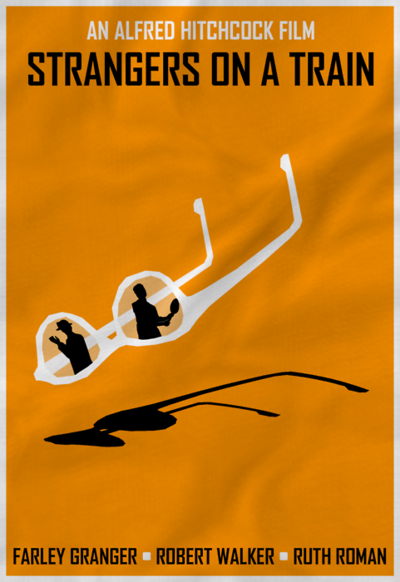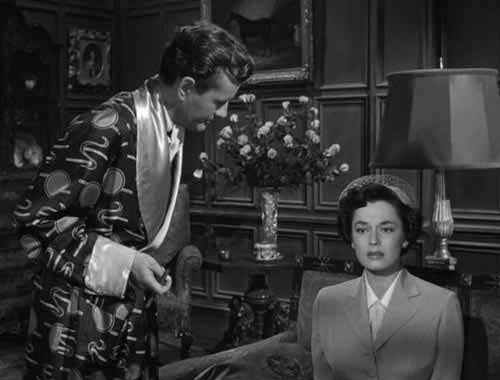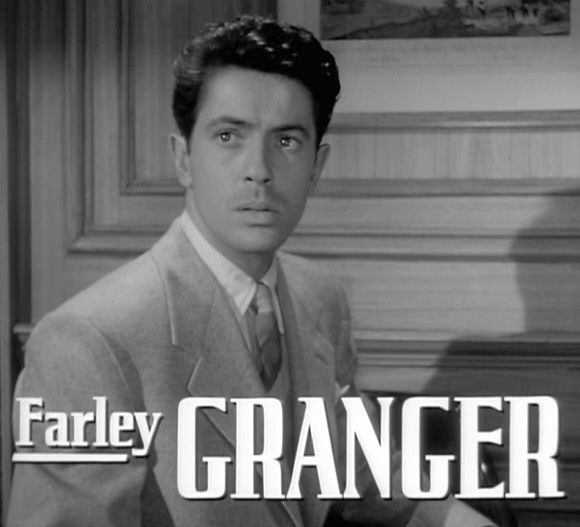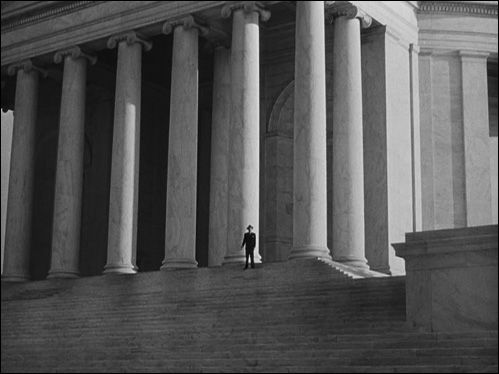 |
| Cool fan made poster art. |
Strangers
on a Train
1951
Director: Alfred Hitchcock
Starring: Farley Granger, Robert Walker
I
haven’t seen all of Hitchcock’s films, but I think by now I’ve seen about
twenty of them. I’ve seen great ones,
and I’ve seen craptacular ones (I Confess… really?!?!?). The more I see of him, the more I tend to
really appreciate the films where he was firing on all cylinders. I didn’t appreciate Strangers on a Train
at first. I do now. Based on a fantastic conceit from Patricia
Highsmith’s novel, Hitchcock must have been falling over himself to get himself
on such film material.
Tennis
star Guy Haines (Granger) has a cheating estranged wife who refuses to make way
for Guy’s new love interest. Rich
playboy Bruno Antony (Walker) has an overbearing father who disapproves of his
son. Bruno meets Guy on a train and
suggests they swap murders, crisscross.
Guy laughs, Bruno doesn’t. Not
too long afterwards, Guy is highly disconcerted to find Bruno at his doorstep,
reporting that the deed has been done.
The rest of the film plays out as Bruno begins to torment Guy into
holding up his end of the “bargain.”
 |
| Evil giddiness right here, ladies and gentlemen. |
There’s
a sense of evil giddiness that’s pervasive in Strangers on a Train that
I find incredibly appealing. This is
almost entirely realized through the amazing performance of Robert Walker as
Bruno Antony. His Antony is insane and
over the top, and that’s putting it mildly.
But he’s also a charmer, an oily con man, who can talk his way into
situations, diverting attention from his true intentions. The evil giddiness is manifested greatly
through Bruno’s flamboyance in not only personality (which, by the way, also
includes classic Hitchcock mother obsession) but also wardrobe. When we first see Bruno, we only see him from
the knees down, and he is wearing a loudly pinstriped suit with black and white
oxfords. When we eventually see his top
half, you’ll note that he’s wearing a tie printed with large lobsters. Seriously, a lobster tie. Next up is one of the loudest dressing gowns
you’ll ever see in a black and white film.
Later, at an elegant dinner party where everyone else is in black tie,
he even manages to stand out wearing white tie with sponge bag trousers. Hitchcock specifically draws attention to his
loud “Bruno” tie clip. I love how the
wardrobe combines with Walker’s performance to create a terrific off-his-rocker
blatantly homosexual psychopath. Walker
is revelatory in the role; tragic, too, considering he died of a drug
complication months after the film wrapped shooting. He shows what he’s capable of here, and it’s
too bad we were unable to get any more crazy psychopaths out of him after
this.
 |
| A lobster tie. I should buy one for my husband. Also, nice placement of the lighter. |
But
Walker’s portrayal of Bruno isn’t the only source of said evil giddiness in the
movie. Guy’s cheating wife Miriam is
sleazy and trampy and cold and calculating, completely in control of her creepy
little world, but made more than slightly comical with her coke bottle
glasses. Guy’s new squeeze Anne Morton
is rather uninteresting, but her younger sister Barbara (played, interestingly
enough, by Hitchcock’s daughter Patricia) is a hoot and a half. Almost as obsessed with crime and murder as
the next door neighbor in Shadow of a Doubt, she spits out
razor sharp observations that are of the type usually left unsaid. And lastly, there’s Bruno’s mother, only in a
scant few scenes, but highly memorable as a doddering old lady who clearly has
no idea – or doesn’t want to, at least – that her son is a raving lunatic.
 |
| I can't even tell what it is that's supposed to be on his smoking jacket, but it's completely ludicrous, whatever it is. |
All
of this adds up to an unexpected humor in this film. Strangers on a Train is marketed as
a film noir, but I can’t quite buy it.
It’s too damn funny to be a noir.
Granted, not laugh out loud funny, but when we cut to a little boy
giggling, his mother shrieking in horror, while he rides the runaway carousel,
you can’t quite take the “drama” seriously.
And then when said little boy starts punching the two main characters as
they duke it out – well, really, I do believe Hitch wanted me to laugh
here.
But
this isn’t a perfect film.
Unfortunately, for how terrific Robert Walker is, for how interesting
the Bruno character is, for all the peppering of oddball characters, Hitchcock
also gives two of the most boring characters of all time in Farley Granger’s
Guy Haines and his new girlfriend Anne Morton (Ruth Roman). Heaven help you when the scene is just the
two of them; I dare you not to fall asleep.
I’ve always thought that Farley Granger had all the acting range of a
piece of linoleum, and he gets to express both of his facial expressions – mild
concern and crooked smile – here in this film over and over again. It’s comical, really, when he and Roman – who
sees Granger’s two facial expressions and raises him a big fat zero – have a
conversation. It’s like watching robots
trying to mimic humans. Robots powering
down…
 |
| This is his "mild concern" face that he wears for 80% of this film. And every other film I've seen him in. |
But
never to fear, we are subjected to a minimum of watching these two saltines
interact with one another. Mostly
they’re surrounded by others far more interesting, and Hitchcock throws in his
classic suspense elements. The
fairground sequence in the first half hour is a great example of a slow build. We know what Bruno is about to do, we keep on
waiting for him to do it, but he waits.
The lauded tennis sequence is once again Hitchcock finding dramatic
tension in an unexpected event, and the carousel finale is just
spectacular.
In
terms of visuals, this is a Hitchcock on top of his game. His black and white photography is top notch
here. We have deep focus shots (a nice
one of Robert Walker close to camera with his bickering parents in a far
distant struck me), play with shadows (watching Bruno’s shadow overtake Miriam’s
shadow in the tunnel of love is fun), and plenty of canted angles. High overhead shots are unexpected and feel
fresh, and Hitchcock throws in some special effects (a lighter appearing in
Barbara’s glasses) to keep us on our toes.
When Bruno starts stalking Guy, Hitchcock does “creepy guy is watching
you” with some fantastically stark scenes; I don’t know if I can choose between
Bruno staring amid the crowd of tennis fans, or Bruno as the sole person on the
steps of a Washington DC memorial, watching from afar.
 |
| Great shot. |
While
I don’t consider Strangers on a Train to be Hitchcock’s finest film, I will say
that my opinion of it has improved dramatically since the first time I saw
it. I originally watched it as part of
my initial blitzkrieg through the 1001 Movies list, and it made little
impression – just a check, seen it, then I moved on. A few years later, I saw it again, this time
on a big screen with my sister, and wow, I liked it a great deal more than I
remembered. It was impressive. And now, watching it a third time to write
this review, I have to passionately admit that I don’t know what I was
thinking, finding it mediocre in my first go-around. Strangers on a Train is good
stuff. Still not Hitch’s best, but very
good.
Arbitrary
Rating: 8.5/10
You like this one more than I do. Perhaps a rewatch is in order for me. The murder scene is fantastic, but anything it gives the film is destroyed (in my opinion) by the over-long tennis scene and the oh-why-won't-it-end carousel sequence. Not his best, not his worst. I'd trade it for The Trouble with Harry or Lifeboat in a heartbeat.
ReplyDeleteI agree that the tennis scene is a bit long, but the fact that it's punctuated by Robert Walker dropping the lighter and trying to find it in the sewer helps me enjoy it. I like the carousel sequence, especially for how darkly comic it is. The old geezer chomping his toothless jaws as he so nonchalantly crawls under the "runaway" carousel is so STUPID it's funny. My husband actually burst out laughing at how ludicrous the whole scene was.
DeleteReally, the first time I watched it, it was a big ole "meh" from me. But it has improved tremendously with subsequent viewings.
I'll conclude by saying I haven't seen either The Trouble with Harry or Lifeboat, so I can't comment on those.
OH, and I forgot to mention in my review so I'll mention it here, but I've seen episodes of NCIS, Bones, and Castle that rely on the central conceit from this. And that's only from the procedural shows that I watch. I wonder how many times the idea has been used!
Throw Momma From the Train and Horrible Bosses at the very least. It's a pretty ingenious little conceit, so it's bound to be reused a number of times.
Delete"Evil giddiness"! That is an excellently succinct way of summing up the fun of this movie. I agree with your assessment: not the best Hitchcock joint, but a really good one.
ReplyDeleteAnd thank you for cluing me in to Barbara being played by Hitch's daughter. I did not do my homework and I did not know that tidbit, but it makes perfect sense; I did think it was highly amusing that there was a character in the movie that had that Hitchcockian sense of fascination with the macabre, not realizing she came by it via heredity!
- Sunny D
Thanks! And hey, this was my third time watching the film, but it's the first time I picked up on the fact that Patricia Hitchcock plays Barbara. Knowing, however, that Barbara's played by Hitchcock's daughter turned her from a character I had been mildly annoyed with in previous viewings to one much more interesting from a psychological standpoint. Hitchcock just can't help himself sometimes!
Deletesupreme
ReplyDeletemoncler
yeezy
nike x off white
fila
hermes birkin
golden goose
christian louboutin shoes
balenciaga
nike shox for men